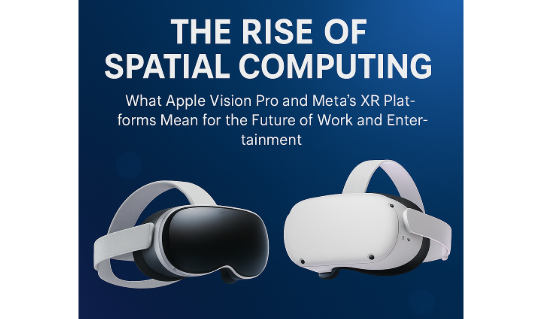The term spatial computing is no longer a buzzword confined to research labs or tech expos—it’s now shaping mainstream consumer experiences, productivity paradigms, and digital entertainment. With the commercial release of Apple Vision Pro and Meta’s continued investment in the Quest series, the extended reality (XR) landscape is entering a transformative phase. These platforms are not just headsets—they are spatial computers that redefine how users interact with digital content in physical space.
Understanding Spatial Computing
At its core, spatial computing refers to the convergence of physical and digital realities through technologies that allow computers to understand and interact with 3D environments. This includes a mix of augmented reality (AR), virtual reality (VR), and mixed reality (MR). Spatial computing blends these realities to enable intuitive user interfaces where gestures, eye-tracking, voice commands, and real-world context play a critical role.
Unlike traditional computing that relies on screens, keyboards, and mice, spatial computing uses sensors, AI, and machine learning to let users manipulate digital objects as though they exist in the real world.
Apple Vision Pro: Setting a New Benchmark
Apple’s entry into the XR market with the Vision Pro marked a significant turning point. Unlike many VR devices focused solely on gaming, the Vision Pro positions itself as a spatial computing device, intended to augment daily workflows and entertainment.
Equipped with dual 4K micro-OLED displays, LiDAR sensors, and the custom-designed R1 chip for ultra-low latency sensor fusion, the Vision Pro delivers an immersive experience with unparalleled visual fidelity. Eye-tracking, hand-tracking, and voice input are native, enabling a zero-controller paradigm. The operating system, visionOS, integrates seamlessly with Apple’s ecosystem, letting users extend their Mac desktop into a floating virtual screen, browse Safari in mixed reality, or engage in immersive FaceTime meetings with spatialized audio and avatars.
Apple’s design philosophy emphasizes pass-through AR, allowing users to remain grounded in their physical environments while interacting with layered digital content. This approach reduces cognitive dissonance and promotes continuous presence—crucial for sustained productivity and long-term use.
Meta Quest 4 and the Democratization of XR
While Apple aims for a premium market, Meta is doubling down on accessible, mass-market solutions with the Quest 4, building on the success of the Quest 3 and Quest Pro. The company’s strategy leans on building a rich metaverse ecosystem with Horizon Workrooms, spatial avatars, and deep integration with productivity platforms like Microsoft Teams and Zoom.
Meta’s emphasis on mixed reality passthrough, inside-out tracking, and spatial anchoring mirrors Apple’s, but at a more consumer-friendly price point. By subsidizing hardware costs and focusing on developer-friendly SDKs via Presence Platform, Meta is empowering a wide array of use cases—from immersive education and virtual co-working to fitness and social gaming.
The introduction of neural input interfaces and advancements in haptic feedback further demonstrate Meta’s ambition to move beyond novelty and toward deeply immersive, functional XR experiences.
Impact on Work: From Screens to Spaces
In enterprise and professional settings, spatial computing is revolutionizing how teams collaborate, design, and build. Architects are using tools like Unity Reflect and Autodesk XR to model buildings at life scale. Surgeons are practicing complex procedures with spatial simulations via HoloLens and Osso VR. Meanwhile, remote teams are finding new presence and engagement with virtual collaboration platforms like Spatial, Immersed, and VSpatial.
With spatial computing, a multi-window desktop becomes an infinite workspace, enabling simultaneous access to apps, documents, and media—without physical monitors. Combined with AI-driven context awareness, spatial UIs can anticipate user needs, dynamically surfacing relevant tools and data.
As hardware becomes more ergonomic and battery-efficient, we are likely to see a shift from experimental deployments to mainstream workplace integration, especially in sectors like design, healthcare, engineering, and remote consulting.
Entertainment in the Spatial Era
Entertainment is perhaps the most obvious and immediate beneficiary of spatial computing. With Vision Pro’s support for Apple TV+ in spatial cinema mode, users can watch films in a virtual theater with dynamic head tracking and spatial audio. Similarly, Meta’s Quest platform offers 360-degree immersive concerts, interactive storytelling experiences, and virtual sports viewing.
Game studios are beginning to harness spatial APIs to build MR-native games, where physical room boundaries become part of the gameplay. Fitness platforms like Supernatural and FitXR are also evolving into full-body, spatially aware routines that merge gaming, exercise, and social interaction.
As generative AI continues to integrate with XR platforms, real-time content personalization and adaptive storytelling will likely become core components of spatial entertainment.
The Road Ahead
The future of spatial computing depends on three pillars: hardware miniaturization, cross-platform development, and interoperability standards. With companies like Qualcomm, Niantic, and Microsoft investing in open XR frameworks, we are inching toward an ecosystem where devices, apps, and experiences can flow freely across different platforms.
Privacy and safety will also be key. The proliferation of eye-tracking data, spatial maps, and biometric feedback introduces new challenges in data governance and ethical design. Clear regulatory frameworks and transparency in user data use will be essential as spatial computing becomes more integrated into our lives.
Final Thoughts
Spatial computing isn’t just a technological leap—it’s a paradigm shift. The Apple Vision Pro and Meta’s XR platforms are not simply devices, but portals into a new mode of interaction where the digital world is no longer bound to a screen. Whether in the office, the classroom, or the living room, spatial computing is laying the foundation for a post-screen era—where reality itself becomes the interface.


